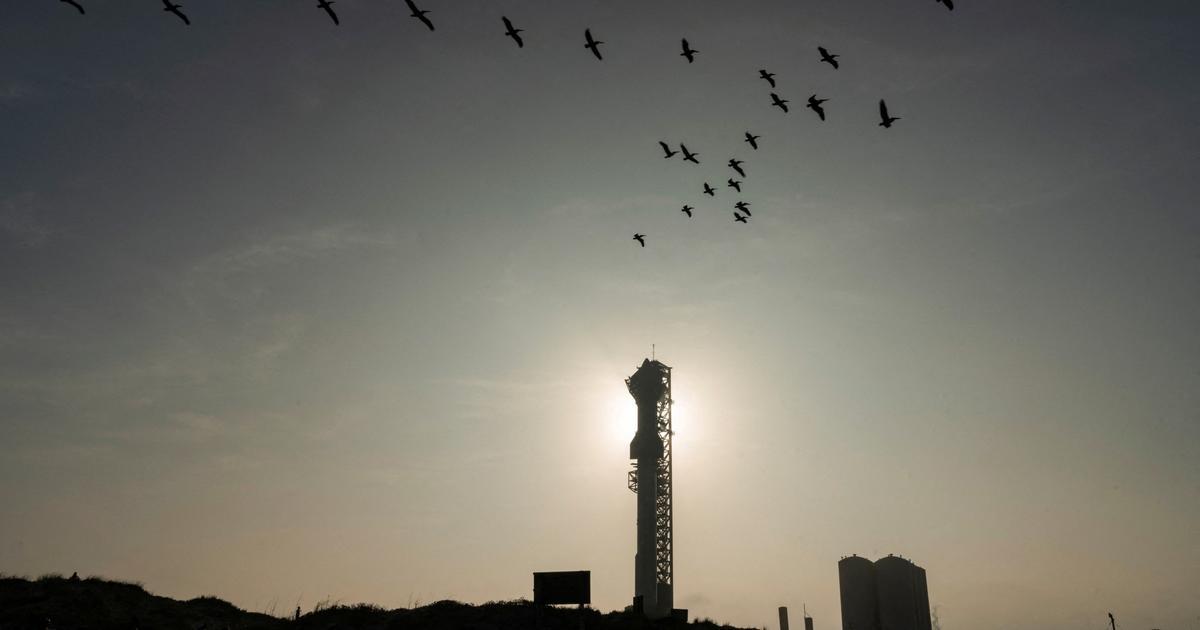After two first tests completed in spectacular explosions, SpaceX's immense Starship rocket must take off again on Thursday, for a test flight including a long list of objectives, including a first controlled return to Earth.
At 120 meters high, Starship is the largest rocket in the world.
She is also the most powerful.
Takeoff for this third test flight should take place from 7 a.m. local time (12:00 GMT) from SpaceX’s
“Starbase”
space base in Boca Chica, in the far south of Texas.
The weather, although not ideal, could however cause a postponement.
Billionaire Elon Musk's company is banking on Starship to achieve its stated goal: to install an autonomous colony on Mars, in order to make humanity a multiplanetary species.
Its development is also very important for NASA, which is counting on this vessel to land its astronauts on the Moon during its Artemis 3 mission, planned for 2026. The rocket is made up of two stages: the Super Heavy propulsion stage, and above the Starship, which by extension gives its name to the entire rocket.
“Reach orbit”
The last test took place four months ago.
The rocket's two stages had successfully separated in flight for the first time, but then both exploded.
The ship, however, had reached an altitude of approximately 150 km, exceeding the edge of space.
SpaceX then proposed to the American air regulator, the FAA, 17
“corrective measures”
, which had to be put in place to obtain a new flight license, finally obtained on Wednesday.
For this third test, SpaceX said it wanted to accomplish several
“ambitious objectives”
.
Among them: carrying out
“a controlled reentry”
of the vessel, which will have to fall back into the Indian Ocean to end the test, after about an hour.
The first stage must also dive (much sooner) into the ocean after separation.
Elon Musk said in January that the spacecraft should this time
“reach orbit”
during the flight.
SpaceX also wants to test the opening of the hatch which could be used in the future to release cargo, for example satellites, into space.
The company also wants to carry out the
“demonstration of a fuel transfer”
in flight.
According to the specialist press, this transfer could take place between two tanks inside the vessel.
Developing this function is essential, because to reach the Moon, Starship will have to refuel once in space, thanks to a vessel previously filled by others, and serving as a sort of space service station.
A SpaceX method
For these tests, the prototypes used do not carry any cargo.
And SpaceX has already manufactured numerous copies of its rocket.
SpaceX's development method is different from that of traditional companies and national space agencies.
Unlike the latter operating with taxpayer money, SpaceX uses its own funds, allowing it to take more risks.
The company also boasts an iterative development technique, based on successive tests linked together at a rapid pace -- even if they end in impressive balls of fire.
The lessons learned then allow changes to be made quickly.
With each test,
“we learn something new
,” Elon Musk declared in January in a speech to employees.
“It’s always better to sacrifice material than to sacrifice time.”
The development of SpaceX's Falcon rockets, which with 96 successful missions in 2023 today dominate the American launch market, was also based on multiple failed tests.
An imperative to be able to “colonize” Mars
Besides its disproportionate size, the real innovation of Starship is that it must ultimately be entirely reusable.
Currently, only the first stage of the Falcon 9 rocket returns to land after each launch to be reused.
Being able to fly Starship's two stages multiple times will allow even more frequent launches, and for less money - an imperative to be able to
"colonize"
Mars, according to Elon Musk.
The boss, always optimistic in terms of schedule, said this week that he hoped that Starship would carry out
“six more flights this year”.

